Apple-tree Aport: high-yielding and large-fruited variety
Aport is a large-fruited apple variety with an ancient history. It grows best in regions with short, cool winters and hot summers.
Content:
- Apples Aport: description
- The history of the Aport variety
- Reproduction and planting
- Apple tree care Aport
- Diseases and pests
Apples Aport: description
The tree of the Aport variety is vigorous, height is about 6 m, width is up to 7 m. The crown is spreading, round. The number of skeletal branches is small. Apples are prized for their fruit size, pleasant aroma and pulp taste. The size of the first fruits reaches 600, or even 700 g. Gradually, they become smaller, but their number increases. The fruits of mature trees reach 300 g. This is much more than that of many other varieties.
Fruits are slightly ribbed, broadly conical in shape. They have a dense skin of yellow or yellow-green color, painted with a red-brown blush. It is covered with a waxy coating that protects the fruit from some external influences and allows it to be stored for a long time in winter. The pulp is tender and crumbly, white or creamy, aromatic. The smell of Aport apples is so strong that it clogs the aroma of any other fruit variety.
The apples taste sweet and sour, slightly spicy.
The apple tree Aport has one major drawback. This is a cyclical fruiting, the period of which for an apple tree of this variety is 4 years. After she gives a full harvest (up to 180 kg), the next year the apple tree will bloom, but the harvest will not exceed 40 kg. In the third year, 60 kg of apples can be harvested. The cycle is over, and in the fourth year there will be a big harvest again.
The fruits ripen in September. They keep well in the winter until the New Year. They can lie longer, but then the pulp becomes overripe and tasteless. You can store apples in the cellar. But there should be no potatoes nearby, otherwise they will take in her smell. Can be stored on the balcony, but in this case, the boxes need to be well covered.
The history of the Aport variety
This is one of the oldest varieties. The first news about Aport apples dates back to the second half of the 12th century. Some sources associate the name of the variety with the fact that it was brought to Poland from the Port of the Ottoman Empire. Then it began to spread through the territory of Ukraine to Russia.
The variety is widespread in the vicinity of Almaty (Kazakhstan). The trees there grew large, and the harvest exceeded those in neighboring regions. This is due to the fact that the most comfortable for the variety are mountainous regions of the middle climatic zone. Unfortunately, now this variety is on the verge of extinction in Kazakhstan. The variety came to Western Europe in the 19th century, and then moved to America.
To date, about 40 clones and varieties of this variety have been created. Among them:
- The aport is blood red with yellow fruits of sweet taste.
- Aport of Alexandria with green fruits with a red blush and sour taste.
- The Zailiyskiy aport is the sweetest, but the fruits are small.
The advantage of the Aport variety is its self-pollination. Aport does not need other pollinating varieties for fruiting. The disadvantage is the average resistance to frost. In regions where they exceed -25 ° C, trees freeze or do not bear fruit. Ukraine, the middle zone of Russia and mountainous regions with winter temperatures above 25 degrees Celsius are considered suitable for growing Aport apple trees. The apple tree Aport begins to bear fruit at the age of 10 years and later. It can give a crop up to 40 years.But for this you need to properly care for her.
Reproduction and planting
Apple seedlings Aport are obtained by planting seedlings. At the age of two, they are planted in a permanent place. It should be sunny, sheltered from cold winds. The depth of the groundwater must be at least one and a half meters. If they come closer, drainage from broken bricks and stones is laid on the bottom of the pit, and the tree is slightly raised above ground level.
Inspect carefully before buying root system sapling.
The root collar should be well defined, the trunk should be straight, the roots intact. Otherwise, the seedlings will not take root or die in the first winter. The length of the roots must be at least 40 cm. The trunk is cut at a height of 80 cm. If the roots are less than 40 cm, the trunk is cut even lower.
The roots of the apple tree Aport are soaked in water for a day before planting. To stimulate the active formation of new roots, solutions of Heteroauxin and Kornevin are used. The pit for planting an apple tree Aport is prepared six months before planting. The diameter and the depth of the pit is 1 m.The removed soil is mixed with humus, compost, sand, add wood ash, mineral fertilizers.
But it happens that the decision to plant a tree comes unexpectedly, then:
- It is advisable that at least 3 weeks pass from preparing the pit to planting the tree. This is necessary in order for the prepared soil to settle.
- It is better to plant seedlings after purchase. But sometimes you have to store them for several days in a pit.
- They dig a trench, lay seedlings and lightly sprinkle them with earth. Moisten the soil.
- Before planting, a clay chatter is prepared, into which the roots of the tree are dipped before planting. After the procedure, they should dry for about 20 minutes.
- A mound of harvested earth is poured at the bottom of the pit. A peg is placed for tying a tree.
- Carefully place a seedling in the hole, spreading the roots in different directions along the mound.
- Sprinkle them with earth, pouring water over each ball and compacting it. They look carefully so that the root collar does not fall under the ground. This can lead to the development of fungal diseases.
- A roller is formed along the perimeter of the trunk circle, which will not let water outside of it. Watering the tree. Mulch a trunk circle with a layer of peat, straw or mown grass with a thickness of at least 5 cm.
Not all gardeners will agree to grow a large tree in the garden that bears fruit every four years. For many, it is enough to pin several branches into the crown of any frost-resistant variety of late ripening.
Apple tree care Aport
Crown formation begins in the second year after planting the tree. You can form it in the form of a bowl, with 3 skeletal branches, or leave a guide and 3-4 skeletal branches.
Care Tips:
- Apple seedlings Aport need constant moisture. They are watered by adding 15 liters of water to the trunk circle. The tree responds well to irrigation. If the amount of moisture is not enough, the taste and size of the fruit will be an unpleasant surprise. But in those years when the apple tree does not bear fruit, it does not need such abundant watering. Excess moisture will be used to build up the mass of the leaves.
- The aport does not have any particular problems with crown thickening. But still, an adult tree needs to be pruned every year. In early spring, before the start of sap flow, the branches growing inside the crown, crossing or broken, are removed. Cut branches that grow at an acute angle to the trunk.
- They begin to fertilize the apple tree in the second or third year after planting. In the fall they bring organic fertilizers (humus, compost). The first 3 years after the application of superphosphate and potash fertilizers, they dig up the soil in the near-trunk circle to a depth of 15 cm. Later, at a distance of 45 cm from the trunk, they dig a trench or separate holes and apply fertilizers there. Cover them with a layer of soil.
- Watering is also necessary along the perimeter of the crown. Pour as many buckets of water as the age of the apple tree. The first time it is done in June, the second - in July. The third time is watered in the fall, before the onset of frost.This will help the tree endure the winter frosts more easily.
- In addition to watering, the trunk of a young tree is wrapped in spruce branches, burlap or other covering materials. Wrapping in straw is dangerous because mice can start in it. Such protection will protect the trunk from frost and from hares that are not averse to gnawing the bark of a tree. The root system can be protected by placing a thick layer of mulch in the tree circle.
- In spring, bright sunlight can burn the thin bark of a tree. If it is open, paint it with lime. In addition to sun protection, such treatment will help get rid of pathogens of some diseases and pests that winter on the trunk. All thick branches, up to 4 cm in diameter, are processed.
Diseases and pests
Common tree diseases:
- One of the most dangerous diseases of the Aport apple tree is cancer. It manifests itself in the fact that thickenings appear on the trunks. Then the bark and wood begin to rot. Wounds are open and closed. Depressions appear near open ones, on closed ones - growths and a red border. Low temperatures are considered the main cause of the disease. It makes sense to fight the disease only when the defeat has not covered a large area. Areas with damage are cut off. They take them out of the garden and burn them. Cut traces are covered with garden pitch. If the lesion has spread, the tree must be burned completely.
- Defeat with black cancer is in many ways similar to defeat with normal cancer. A wound parasite causes the disease, which gets under the bark if the bark is cut too early or if the bark is damaged. When damaged by black cancer, the bark on the trunk and branches cracks, exfoliates. The disease affects the leaves and fruits. For the prevention of the disease, after cutting the cut surface, they are treated with disinfectants.
- Scab is not such a dangerous disease, but it can lead to the death of the tree. The disease manifests itself as yellow oily spots on the leaves. which gradually dry out. Other parts of the plant are affected, including fruits that are covered with dark spots.
- Powdery mildew manifests itself as a white bloom on the leaves. After a while, it turns brown. Treatment is carried out with Bordeaux liquid, Skor, others fungicides.
Disease of fungal origin. It is necessary to treat and process for prevention several times during the growing season with preparations containing copper. In early spring it can be Bordeaux liquid, later Skor and other fungicides are used.
The main pests of the apple tree Aport:
- The hawthorn eats leaves, buds and flowers.
- The apple weevil eats the buds.
- Fruit mites feed on plant sap.
- Caterpillars leaf rollers destroy the leaves.
You can fight them by spraying with a solution of insecticides "Zircon", "Agravertin".
More information can be found in the video:



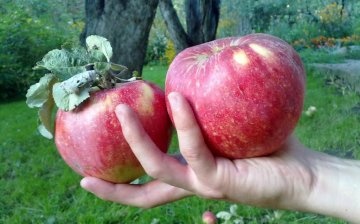


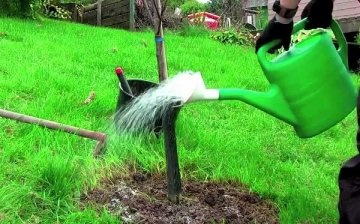
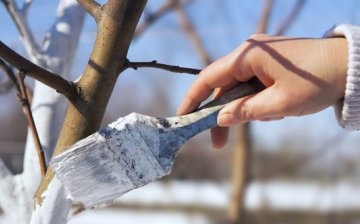
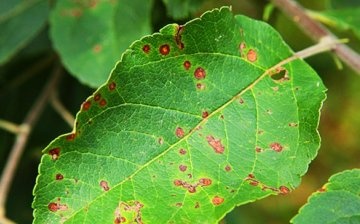






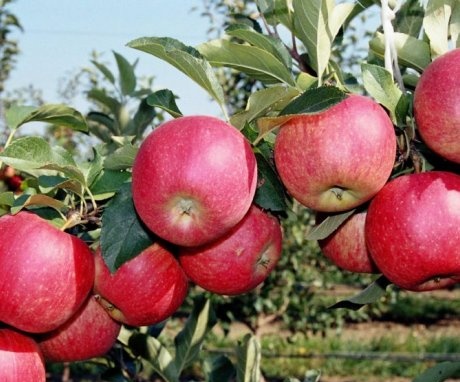
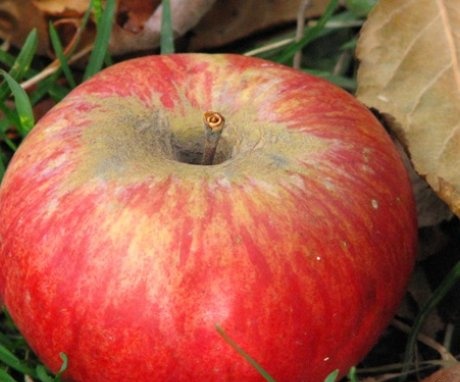


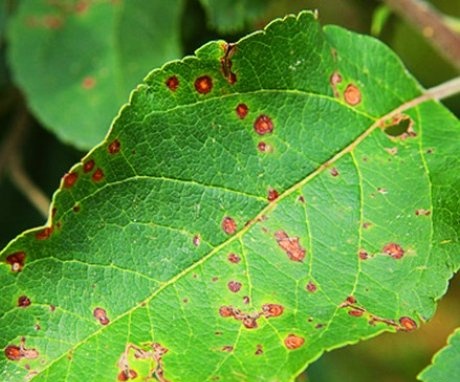
Delicious apples, I just love this variety! Last year, it was my husband who grafted the aport to the apple-pear. Perhaps this year the fruits will already be the first, because both are picky about leaving.
This variety was at one time very popular in our region, it has an excellent yield, the fruits are juicy and quite sweet, and most importantly they are well stored. Nowadays, apple trees of other varieties dominate, but if you wish, you can buy aport apples.